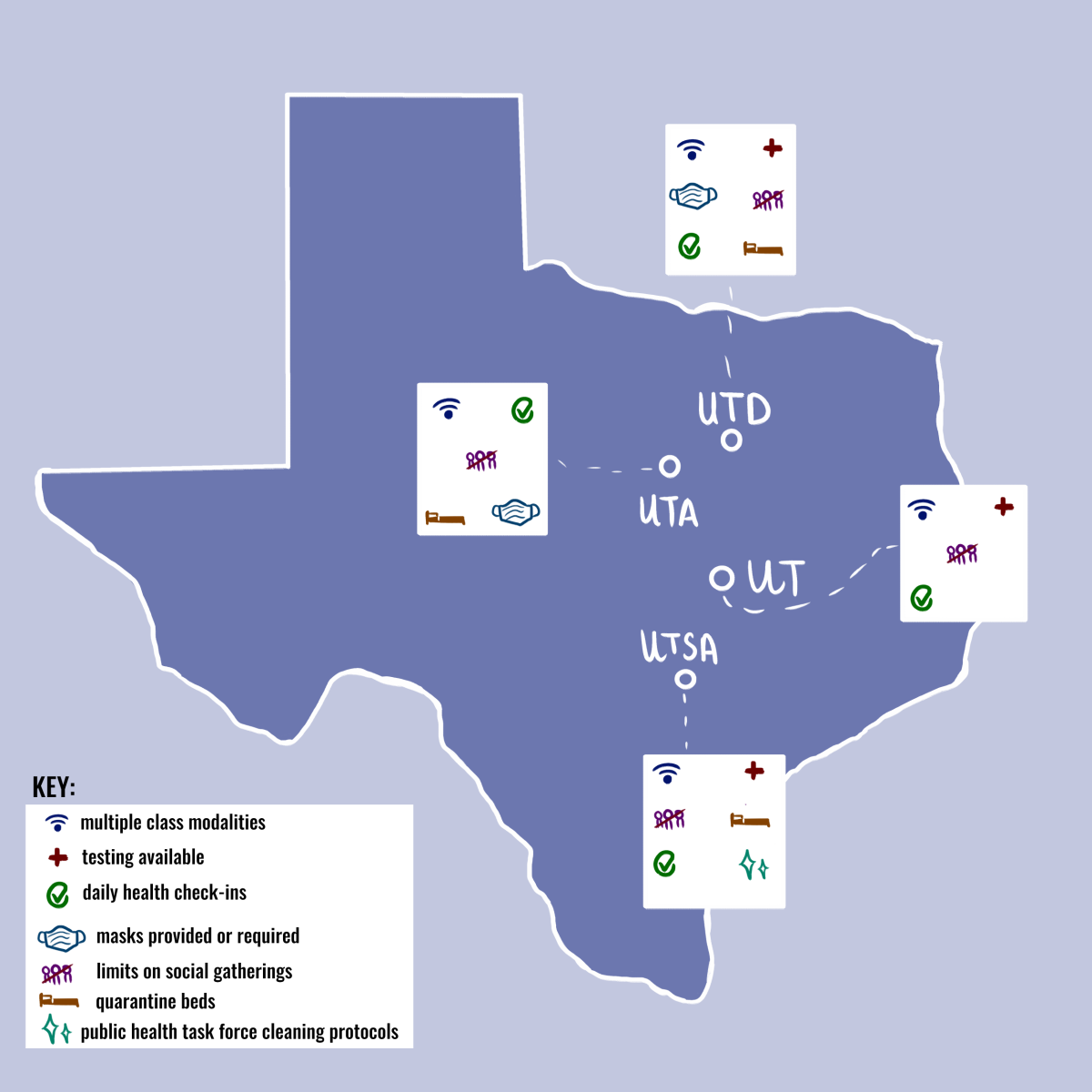Texas’ coronavirus response has evolved over the past few months on account of the rapidly changing situation, and the state’s universities have adopted different approaches to combatting the pandemic.
The state has seen over 800,000 confirmed cases so far and upwards of 17,000 fatalities. In early October, Governor Greg Abbott issued new guidelines to reopen some public venues at 75% capacity and allowed the resumption of elective surgeries in certain counties.
Texas universities have also been making efforts to resume operations while keeping students and faculty safe. UT System schools are offering classes in online, in-person and hybrid formats. This limits the number of people on campus and allows students who are not comfortable returning to campus to stay home. UT San Antonio is offering live tech support from 7:30 AM to 6 PM on weekdays to help students navigate their virtual classes.
Both UT Austin and UTSA are quantifying their level of campus operations on a scale from fully on-campus to fully virtual. UT Austin is currently at level three on their five-level reopening scale. UTSA also lists their status as level three, but on a four-level scale.
Many UT System schools now require a daily self-assessment of students and employees on campus to see if they are exhibiting symptoms of COVID-19 or have recently come into contact with anyone who has reported symptoms.
“We have a Dean of Students team of campus tracers who follow up with each student that reports these things,” said Amanda Smith, dean of students and associate vice president for student affairs.
However, these assessments vary in their level of thoroughness. UTA’s self-assessment tool requires a temperature check, while UTD (through their Daily Health Check) and UT Austin simply ask students to report their symptoms. UT Austin has taken the idea of the self-assessment one step further with its Protect Texas Together app. This app allows students to log their symptoms as well as what buildings they have visited on campus to aid contact tracers should they test positive. Contacts identified through such means will receive test results within a 15-minute window so that they don’t have to quarantine unnecessarily.
All UT system schools have placed limits on gatherings taking place on campus. In an Aug. 21 announcement from Student Affairs, UTD announced that all in-person gatherings held by student organizations would be strictly prohibited until further notice – with a few exceptions. UT Austin’s restrictions are a little less stringent: they have limited campus events to 10 attendees or fewer unless a larger event is approved. UT Austin and UTD have made similar changes to their academic calendar this semester. At both schools, all in-person instruction will be ending before Thanksgiving. Any final exams or remaining instruction will be conducted remotely to prevent students from traveling home for Thanksgiving and potentially bringing the virus back to campus.
Students and employees at UT System schools can access coronavirus testing on or near campus. UT Austin’s proactive community testing program provides free testing even for those who have not shown symptoms or been exposed to COVID-19. The program was created to isolate asymptomatic carriers and has thus far identified 246 of the campus’ 1474 total known coronavirus cases. As a larger school, UT Austin anticipated the high volume of coronavirus tests they would have to conduct. This summer, they purchased three robots that sort saliva samples and quickly identify viral genetic material.
UTSA offers free testing for current students who show symptoms and complete a telemedicine evaluation. The results of these tests are available in one to three days. Off-campus testing is available to all students, faculty, and staff – even those who are not symptomatic – and results are received within 24 hours. UTSA has had 35 positive coronavirus cases so far.
Smith encouraged students who think they might have COVID-19 to get in touch with the Dean of Students office to discuss next steps.
“We have had some students indicate they are afraid to report positives, symptoms or exposure because they are embarrassed or worried about what will happen when they do,” Smith said. “The Dean of Students staff is very sympathetic to the students who report and want only to support them and assist them in keeping themselves and our campus safe.”





